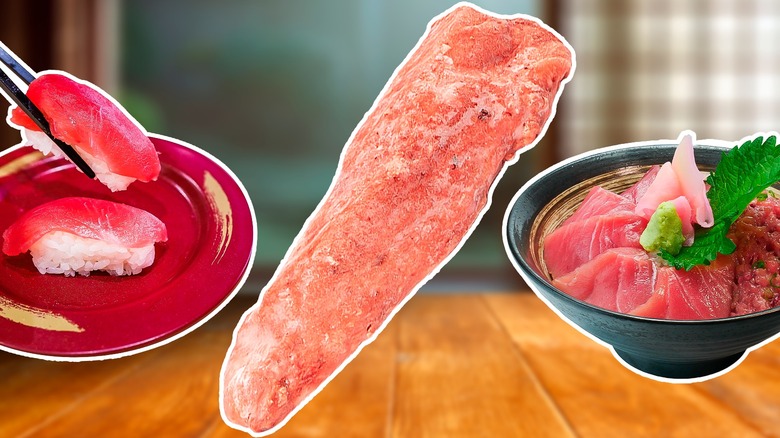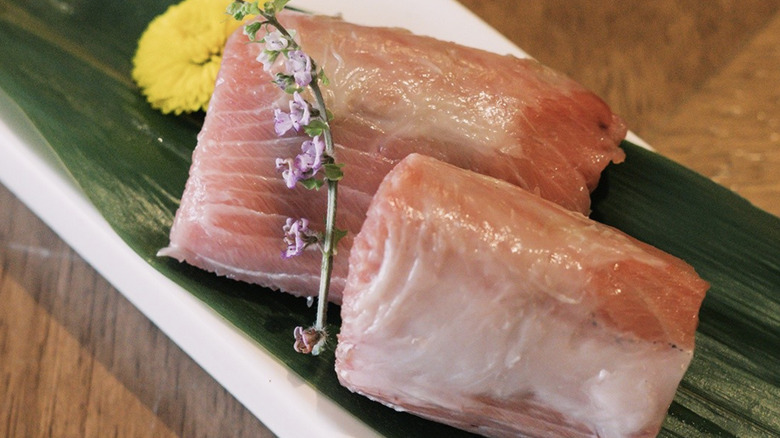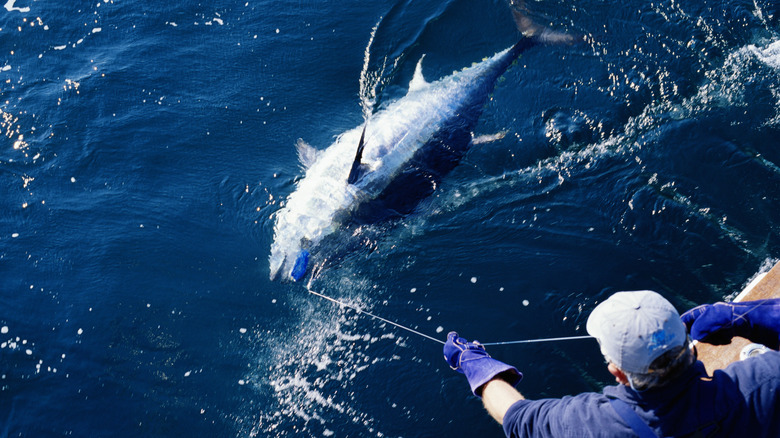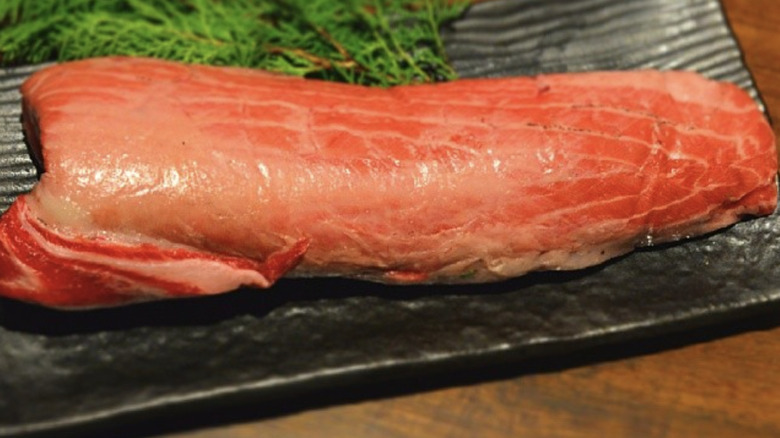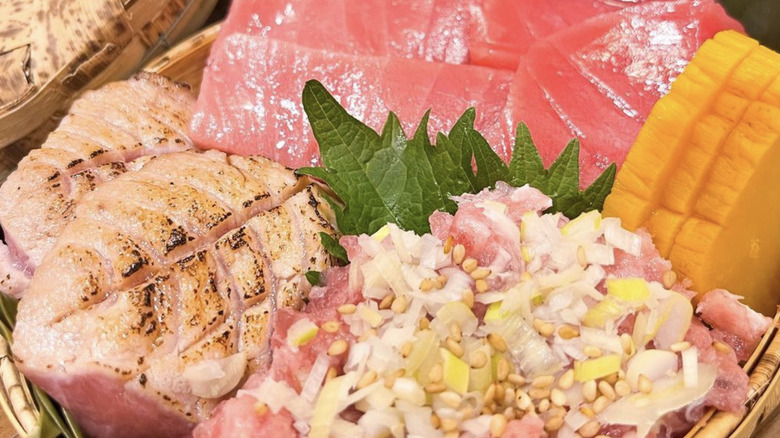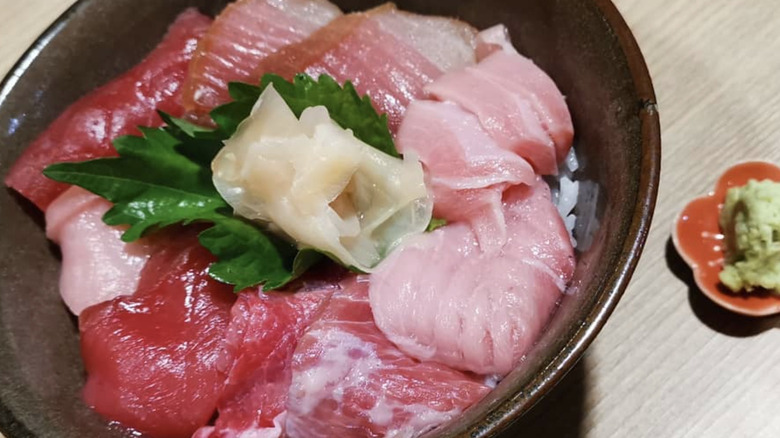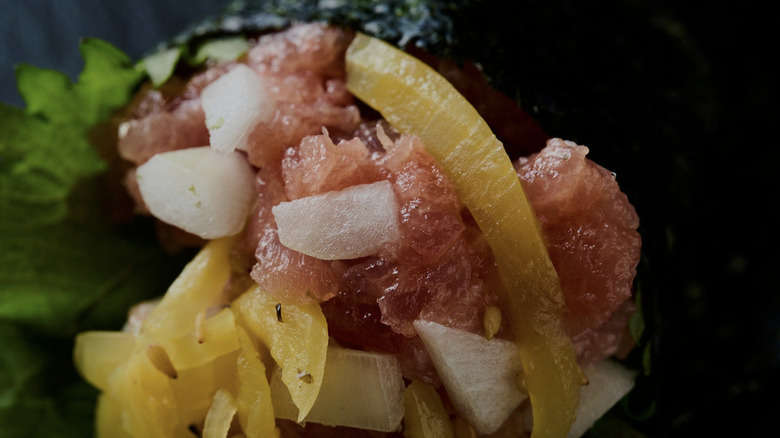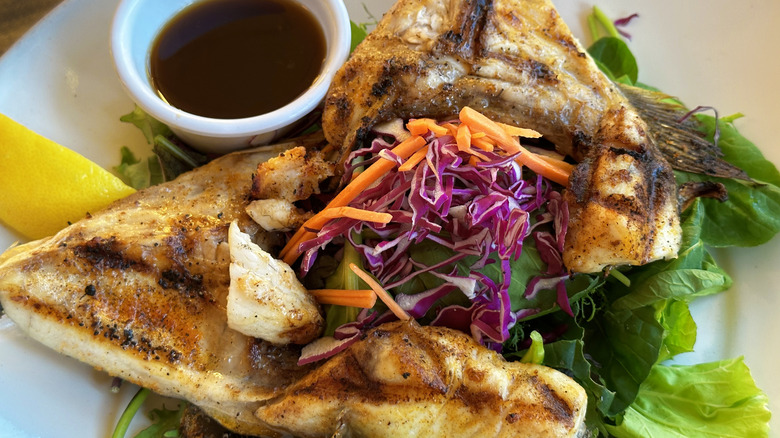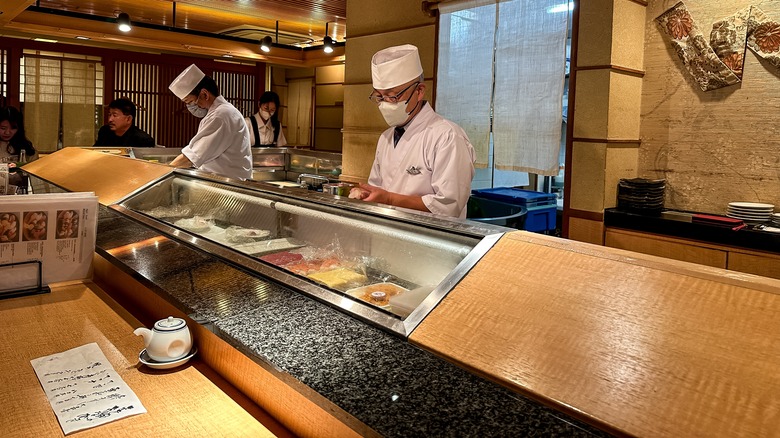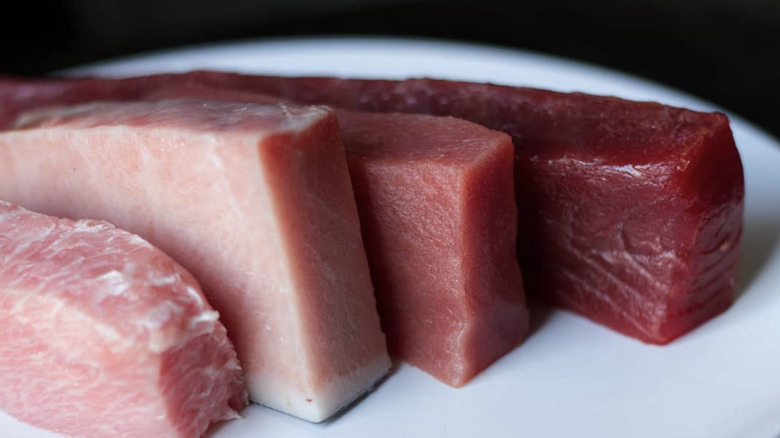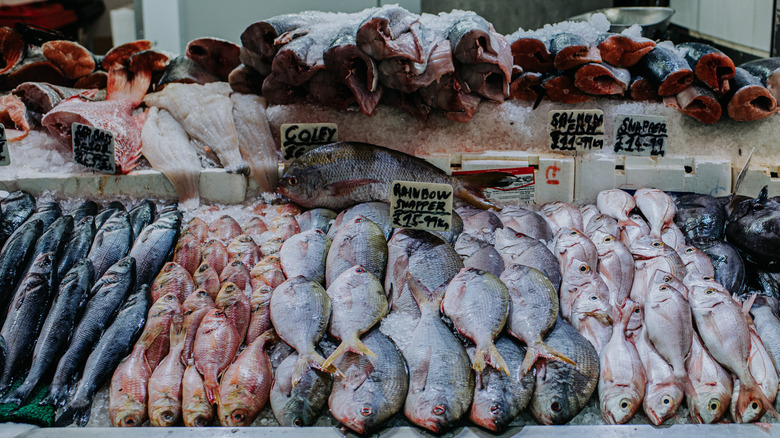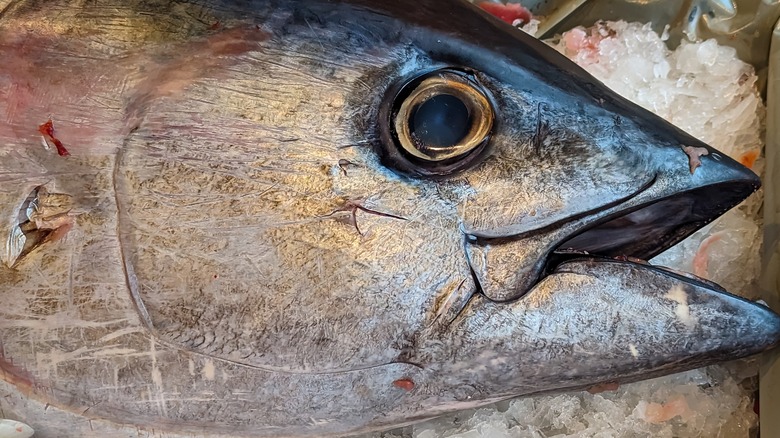Noten Is The Fatty Cut Of Tuna That's Truly A Rare Find
For savory seafood lovers, plopping down at a sushi counter is the equivalent of locking someone with a sweet tooth up in a candy store. There are so many different tastes, textures, and sensations to enjoy — especially if you are ordering omakase at a Japanese restaurant. Sure, you'll find delicate pieces of sashimi, yellowfin, mackerel, and more, but if you're lucky, you may come across a cut of fish that you may have never heard about before: noten.
This fishy delicacy is truly one of the cuts you need to sample if you consider yourself a devout sushi fan — or simply if you have an expensive taste. To give us the rundown of what noten is, where it comes from, and most important, how much you should expect to pay for it, we sought the guidance of sushi chef Jacobo Ramirez from Uchiko, a Texas-based Japanese restaurant with locations in Austin, Houston, and Plano.
What is noten?
In short, noten is a cut of fish sourced from the top of the head, a spot that's commonly called the crown. Since fish only have one head, noten is considered to be a rather rare cut and isn't as widely available as other parts of the fish, from the belly and the like, that you might see at your local sushi counter. Tuna, for example, will only have about 200 grams total of noten — and each fish only comes with two pieces. That's especially astonishing, considering that bluefin tunas average about 130 pounds.
Noten can be derived from many different species besides the tuna, as chef Ramirez notes. "You can find it in basically every fish head," he explains. "Obviously, the best ones are going to be from larger fish, such as tuna, amberjacks — or any jack really." Ramirez also says that he has come across a lot of grouper noten during his time as a sushi chef.
The different types of noten
There are several different types of noten. The taste and application of each of these types of fish will vary — but not as you might think. Ramirez explains that the taste of grouper and snapper noten is a little milder than that of tuna. "When it comes to tuna, the minerality isn't as pronounced as the regular meat in the body," the sushi chef says. "Actually, when it comes to groupers and jacks, it's very similar [to the taste of other cuts] as well."
Ramirez tells us that the main factor that sets these fish apart from the others, in turn making them desirable for this cut, is their shape and size. Snappers, which can be used for noten, are more narrow-bodied, while tunas, jacks, and groupers are wider fish, so they're going to have, as he says, "more room [in the head] to carry meat." As a result, there may be some variation in price between these different varieties of fish and the noten that comes from them. So while you can get noten from other, smaller species of fish, it's easier to pull the meat out when you have more room to work around — and get a larger cut for your labors.
What does noten taste like?
Noten has a very specific taste that is highly desirable in the sushi world. "So this cut is going to be very supple and moist when cooked," Ramirez explains. "It can be extremely tender when you eat it raw — it just sometimes requires a little work to get it there."
Some folks who have sampled tuna noten have described the flavor as being somewhere in the middle of chutoro, a cut derived from the back or the stomach of the fish that is comparatively less expensive than noten, and otoro, the cut from deep within the belly of the tuna. The otoro gives off a slightly sweet flavor, which is also expressed in the noten. In short, the noten has the decadence and soft bite of the otoro, but is slightly leaner, like chutoro. Overall, it has an impressive balance of fattiness and fleshiness, which makes it an excellent option for those seeking a divine sushi experience with a myriad of textures.
What does noten look like?
Noten is rather easy to identify. As far as tuna goes, Ramirez notes that it has a similar color to the leaner portions sourced from the same fish, which he describes as a bright red. "The sinews on the outside will give it a slight white color," the chef explains. "But once you cut into it, it will be just like if you're eating any piece of tuna." Groupers and jacks may look a little different than the tuna but will still be similar in hue to that respective fish variety.
Ramirez also says that the cut of the fish, regardless of the species, is more organic-looking than other cuts of sushi you might get from the counter. "It's not going to be a perfect little block," he tells us. "... Some of the outside may have a couple of little sieves or tissue surrounding it. I like to think of that kind of cut as like the oyster and the chicken — where it's just this little piece that you can just kind of peel off." Ramirez describes this feature as the fish having its own character, which sets it apart from other, neater cuts.
How is noten often prepared?
There are several different ways to prepare noten to capitalize on its unique fatty texture and sublime flavor. Chef Ramirez explains that all cuts and the respective species from which noten is derived are very approachable, but some preparations are more appropriate than others.
For example, due to the perfect synergy of fatty and meaty mouthful on a cut of tuna noten, you'll often find pieces of this fish on sushi and omakase menus, where it's served raw among other cuts of fish. Ramirez prefers, though, to eat tuna noten tataki style, which essentially sears the outside of the meat and traps the moisture inside. This cooking method is great for noten, which has a delicious fatty layer that becomes perfectly cooked next to the heat.
But these aren't the only way to enjoy noten. "I will always suggest to eat this piece [of fish] cooked with the whole head," Ramirez tells us. "I think it yields the most delicious outcome because it's cooked on the bone. You get really moist pieces." You're likely to see this cooking method used for grouper or snapper, as Ramirez suggests, because the fish are more commonly sold head-on. Since bluefin are sometimes sold with the head on — and sometimes not — they are more prized for eating raw rather than cooking down.
Ingredient pairings for noten
There are many different ingredients that you'll find paired with noten, and it's often up to the chef who's making the omakase or sushi menu as to what pairings you'll find. After all, shouldn't you be trusting the professionals?
One example of an excellent pairing is at New York's 69 Leonard Street, a Michelin-starred, Edomae-style sushi haven. Ramirez notes that the head chef has served longtooth grouper head with a broth and vegetables, along with scallions and ginger. However, Ramirez does suggest that diners inquire ahead of time as to if this is going to be on the menu so they can be sure to get a tasting when they visit the restaurant. And by the looks of it, it's one meal that you shouldn't miss.
But you don't have to go to an exclusive omakase restaurant to get your hands on a delicious noten pairing, either. One of Ramirez's recommendations for eating noten is to cook the entire fish head in a warm, flavorful dashi. Dashi is an umami-rich broth made with kombu (seaweed), dried bonito flakes, and other savory ingredients. Ramirez suggests using nine parts dashi to one part soy and one part mirin, saying, "I think any kind of a comforting broth, like that, would be really delicious with noten."
Noten alternatives
Due to its cost-prohibitive nature and relative rarity on the seafood market, finding noten isn't easy. But luckily, chef Ramirez has some suggestions for other alternatives to this cut. He thinks the cheek from the same fish would be "comparable, in the sense that it's an off-cut." Although this distinction might sound a bit derogatory, it's actually anything but. Like noten, tuna (or toro) cheek is often either served slightly seared (tataki) or raw (as sashimi). It's oily, rich, and delectable — which makes it a great substitute for prized noten.
Ramirez also recommends the kama-toro, another cut of tuna that's sourced from underneath the jaw of the fish. The "kama" refers to a broad swath of the tuna, including the gills, fleshy collar, and jaw. It's important to note that the kama-toro is an expensive cut of fish, as well, and is rather oily — so it's not well-suited to all palates. But if you're looking for a similar mouthfeel and flavor, this would be the cut of fish you'd want to go for.
Are there any health risks of eating noten?
The health risks of eating noten are relative. After all, is anyone downing several pounds of the fish in a single sitting? Probably not.
Ramirez doesn't believe that there are any massive risks to consuming this part of the fish — at least in comparison to other cuts from the same animal. "Obviously, there's risk to eating raw tuna or raw fish in general, but I don't think eating it from the head would impart any extra dangers," he shares. For reference, raw fish can contain viruses, parasites, and bacteria, but as long as you are purchasing sushi-grade seafood and preparing it safely or eating at a clean and reputable sushi restaurant that follows the health code religiously, you're likely in good hands. Experts, though, recommend some populations, including pregnant individuals, avoid eating raw fish like noten.
Bluefin tuna, in particular, comes with several positive health benefits: It's a solid source of protein, contains Omega-3 fatty acids, and vitamins like B12, which is needed for cell repair and proper bodily functioning. However, as a large, predatory fish, there are some health concerns that you should be wary of. This large fish — especially larger, older ones — often have greater concentrations of bioaccumulated mercury in their tissues. This means that the maximum amount of bluefin tuna you should consume per week, to limit your intake of this potentially neurotoxin, is about two to three servings.
How to tell you're getting high-quality noten
If you're paying that much money for a bite or two of noten, you're going to want to make sure that what you're getting is high quality. Ramirez has some suggestions for what to look for when you're buying noten, either at a sushi counter or at the store. He shares that if you're buying the fish yourself, you should always take a peek at the eyes: "You always want to look for clear eyes, and then the gills. If they're bright and red, that definitely shows freshness."
The process of looking over your fish at a sushi counter is similar; Ramirez says that your eyes are one of the best tools to help you suss out a good piece of fish. "Look for smell, any slime on the meat itself, and then the color," he advises. "Of course, if it looks extremely oxidized, then it may be past its prime."
On a similar note, Ramirez tells us that, despite the cut's high price tag, the risk of finding fraudulent noten on the market is rather low. "If anything was to happen, it's that someone would sell the noten as maybe another part of the same fish," he says.
Is noten expensive?
We would remiss not to mention the cost of the noten, which will inevitably vary based on location, restaurant, and the type of fish it's from — among other factors. Ramirez suggests that most restaurants would incorporate the price of this selection, like as part of an omakase, into the overall price, rather than making it a special add-on item. "I would expect, however, if it would be like a whole dish, for example ... it would definitely be a premium price." Ramirez references Kyōten as an example; it's a well-regarded Chicago restaurant that serves the cut as a part of its omakase menu. He explains that the restaurant's chef, Otto Phan, serves noten tataki style with ponzu sauce. A seat at this restaurant, for reference, can cost upwards of $500.
Another thing that drives up the cost of noten is the fact that some tunas are sold without the head on, per Ramirez. Most tunas sold will still have the collar attached, and as previously mentioned, grouper and snapper, in comparison, will often come with the head on. So, more cuts are available, which could make this a cheaper alternative to bluefin noten.
Can you buy noten from the grocery store?
Although we highly doubt that your neighborhood Kroger is selling prized cuts of bluefin tuna (for reference, a hefty bluefin tuna sold for $3 million at a Japanese market not too long ago), you still may be able to source out some head-on fish to cook up and enjoy. Ramirez notes that smaller fish, like grouper and snapper, may be able to be found at your local fishmonger — you may just have to ask for it.
Ramirez also shares some tips with us about how to remove the desirable noten from the head of the fish once you can get your hands on it. "If you're removing this piece of meat," he explains, "you're going to want to cut off just the skin very carefully." The chef goes on to describe how he uses a boning or a paring knife to carefully pierce the skin so he can see the meat, before carefully dislodging the cut piece with his finger. Ramirez then uses his knife to remove any of the attached pieces from the body of the fish.
Is noten sustainable?
Bluefin tuna hasn't had the most sustainable rap over the past century. Once the consumer eye started shifting towards the protein in the 1970s, more fish were taken from the ocean than could be regenerated, thus hurling this species (particularly the Atlantic bluefin) down the extinction pipeline — and fast. However, the critical population status of this fish through the '90s and early 2000s didn't stop many people (and restaurants) from indulging in the bluefin at high-end sushi restaurants. After all, bluefin tuna is considered the best tuna variety by many because of how fatty and delicious it is. Luckily, thanks to catch limits and greater regulations, the Atlantic bluefin species was removed from the endangered list and has now been moved to the category of "least concern" by the International Union for the Conservation of Nature (IUCN) — yet is still under the watchful eye of regulatory authorities. So, rest assured you can enjoy your noten without worrying about the plight of the bluefin.
Species like the black grouper and red grouper, which are also popular fish used for noten, have historically been sustainably harvested under U.S. regulations. And if you still have lingering questions about the sustainability of your fish used for noten, always contact your fishmonger or person working the sushi counter.
Why are more people interested in head cuts of fish?
The conversation around noten brings up an interesting question: Why are people so interested in off-cuts of meat? After all, the entrails and leftovers of cows, pigs, and the like are often discarded — so what makes fish different?
Jacobo Ramirez shares his thoughts, reflecting on his career in food and the shift towards more unconventional items — like off-cuts — on restaurant menus. "I think it's amazing, you know, from the time I started being a sushi chef until now, I feel like our dining public has made leaps and bounds in wanting to try new things, and I love the fact that people are excited about this kind of thing," he says candidly. When we ask him more about what prompted this change, the chef traces back to a growing passion for people about food, and diners wanting to try things at restaurants that they wouldn't normally be able to find at home. "It's just that people want to try things that are rare and special," Ramirez remarks.
